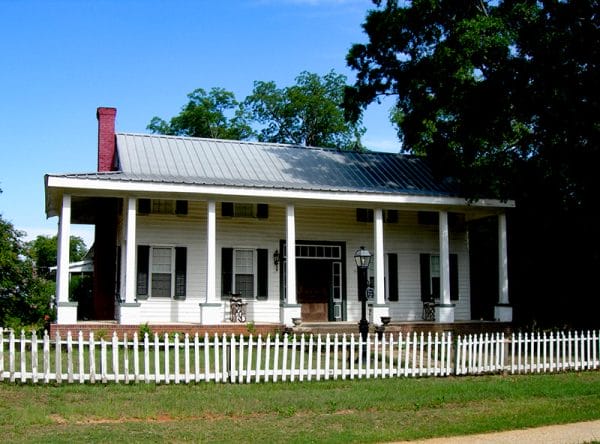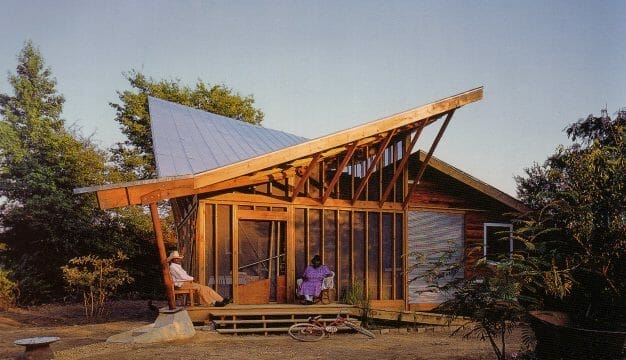Lowndesboro
Lowndesboro is located in northern Lowndes County in south-central Alabama, roughly 15 miles west of Montgomery. From the time of its founding in 1830 until the Civil War, Lowndesboro’s economy centered around cotton cultivation and trade. After the Civil War, the cotton trade ebbed and the population declined. Lowndesboro is now best known for its many historic antebellum structures. Lowndesboro has a mayor-council form of government.
History
 Pecan Place
The site on which Lowndesboro now stands was part of the territory ceded by the Creek Indians with the signing of the Treaty of Fort Jackson, which ended the Creek War in 1814. Beginning in 1815, the area, located just north of the Old Federal Road, was settled by several families from South Carolina. Between 1817 and 1830, spurred by Alabama’s admission to the Union in 1819, the area was extensively settled, mainly by Presbyterians from the Carolinas; it initially was named McGill’s Hill after two of the first settlers, John and Selina McGill. In 1830, McGill’s Hill merged with the nearby community of Loch Ranza and was renamed Lowndesborough (as it was originally spelled) in honor of William Lowndes, the congressman from South Carolina after whom Lowndes County was named. Lowndesboro was officially incorporated as a town by an act of the state legislature in 1856.
Pecan Place
The site on which Lowndesboro now stands was part of the territory ceded by the Creek Indians with the signing of the Treaty of Fort Jackson, which ended the Creek War in 1814. Beginning in 1815, the area, located just north of the Old Federal Road, was settled by several families from South Carolina. Between 1817 and 1830, spurred by Alabama’s admission to the Union in 1819, the area was extensively settled, mainly by Presbyterians from the Carolinas; it initially was named McGill’s Hill after two of the first settlers, John and Selina McGill. In 1830, McGill’s Hill merged with the nearby community of Loch Ranza and was renamed Lowndesborough (as it was originally spelled) in honor of William Lowndes, the congressman from South Carolina after whom Lowndes County was named. Lowndesboro was officially incorporated as a town by an act of the state legislature in 1856.
Its location amid Black Belt cotton plantations and its proximity to the Alabama River enabled Lowndesboro to become a center of the cotton industry. It was also among the earliest sites of the Alabama peach industry. The town was home to families who grew wealthy from the industry and who built large, Greek revival-style homes. Many of these homes survived an 1865 raid during the Civil War by U.S. Army forces under the command of Gen. James H. Wilson. According to local legend, town physician Philip Cilley met Wilson and his troops at the edge of town and convinced him that a smallpox epidemic had struck there; the ruse worked, and most of Wilson’s men bivouacked outside of Lowndesboro. Although its historic structures were spared, Lowndesboro’s economy and population suffered severely after the Civil War, as was the case with many other Black Belt towns.
In 1947, Elmore Bolling, a successful Black businessman, was shot to death near his home in Lowndesboro, apparently in a racially motivated killing. Clarke Luckie, Bolling’s white neighbor, admitted to planning the murder, and NAACP investigators concluded that Bolling’s prosperity was the motive for his murder. No one was ever charged with committing the crime. In 2008, Bolling’s family erected a historical marker at the site of his death.
Demographics
According to 2020 Census estimates, Lowndesboro recorded a population of 75. Of that number, 85.3 percent identified themselves as white and 14.7 percent as African American. The city’s median household income was $41,667, and per capita income was $41,779.
Employment
According to 2020 Census estimates, the workforce in Lowndesboro was divided among the following industrial categories:
- Educational services, and health care and social assistance (50.0 percent)
- Professional, scientific, and management, and administrative and waste management services (26.9 percent)
- Retail trade (23.1 percent)
Education
Lowndesboro is part of the Lowndes County School System. No schools are located within the town itself.
Transportation
The southern tip of Lowndesboro is located at the intersection of U.S. Highway 80 (running east-west) and State Highway 97 (north-south). North of Highway 80, Highway 97 becomes County Road 29, and is known as Broad Street as it passes through Lowndesboro. U.S. Highway 80 connects Lowndesboro to Montgomery (15 miles to the east) and Selma (roughly 30 miles to the west). The closest airport is the Montgomery Regional Airport in Montgomery, Montgomery County.
Events and Places of Interest
 McCurdy Plantation Horse
Lowndesboro’s residents remain committed to preserving the town’s impressive antebellum structures. Many of the buildings in Lowndesboro’s Historic District have been restored and are showcased during the annual Lowndesboro Heritage Celebration. Lowndesboro’s Historic District, which includes many churches, mansions, cottages, and other structures, was added to the National Register of Historic Places in 1973. Rosewood (1855) and Meadowlawn (1853) are two of the most notable Greek Revival mansions. The CME church (1830) is topped by a cupola that was salvaged from Alabama’s first capitol building in Old Cahaba.
McCurdy Plantation Horse
Lowndesboro’s residents remain committed to preserving the town’s impressive antebellum structures. Many of the buildings in Lowndesboro’s Historic District have been restored and are showcased during the annual Lowndesboro Heritage Celebration. Lowndesboro’s Historic District, which includes many churches, mansions, cottages, and other structures, was added to the National Register of Historic Places in 1973. Rosewood (1855) and Meadowlawn (1853) are two of the most notable Greek Revival mansions. The CME church (1830) is topped by a cupola that was salvaged from Alabama’s first capitol building in Old Cahaba.
The Historic District is showcased during Lowndesboro’s annual Heritage Festival, which is held in the spring. The festival features tours, historical reenactments, and a town fair. Many of Lowndesboro’s residents participate by leading tours and telling local stories to visitors.
The McCurdy Plantation Horse, a gaited pleasure-riding breed, was developed by the McCurdy family on their farm in Lowndesboro. They continue to raise these horses for sale and breeding.
Additional Resources
Hale, Jennifer. Historic Plantations of Alabama’s Black Belt. Charleston, S.C.: The History Press, 2009.
Jeffries, Hasan Kwame. Bloody Lowndes: Civil Rights and Black Power in Alabama’s Black Belt. New York: New York University Press. 2009.
The Heritage of Lowndes County, Alabama. Clanton, Ala.: Heritage Publishing Consultants, 2005.
Lowndesboro’s Picturesque Legacies. Lowndesboro, Ala.: Lowndesboro Heritage Society, 1979.



